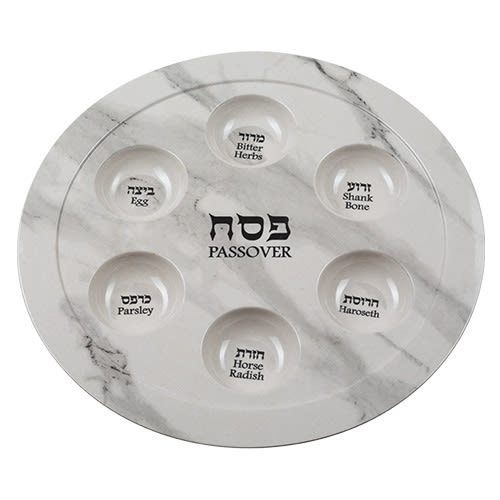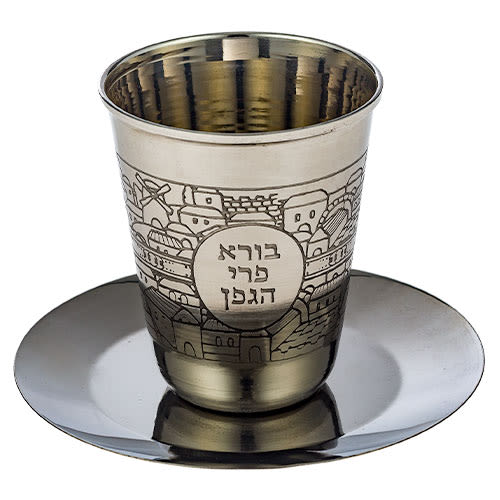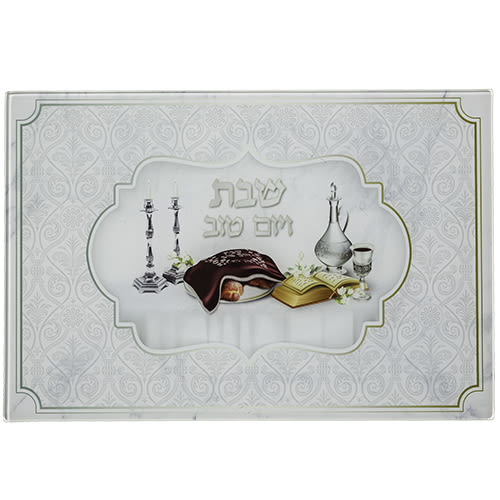
Tallit – Breslev The Way It Is
Rabbi Elazar Kenig first holds the talit slightly over his head in preparation to wrap himself in it; he recites the berakhah; covers his upper body and head to the level of...

Le‘ilui nishmat Leib ben Yitzchak Ya’akov Sears, a”h – Yartzeit: 30 Shevat, Rosh Chodesh Adar
Le’ilui nishmat Yosef ben Shmuel Zeitlin, a"h Yartzeit: 18 Menachem Av
We continue with our new series of minhagim and hanhagot tovot of Breslov. We invite you to peruse our previous entries by accessing our archives.
Tzitzit / Talit (continued)
Each corner of the arba’ah kanfot should have two horizontal holes in the form of a tzeyre, following the view of the ARI zal. This seems to be a universal Chassidic minhag (Rabbi Chaim Vital, Pri Eitz Chaim, Sha’ar ha-Tzitzit, citing Baal ha-Ittur; also see BaCH on Orach Chaim 11; Rabbi Moshe of Dalina, Seraf Pri Eitz Chaim, Sha’ar ha-Tzitzit, 5, with commentary Shivchei ha-Pardes, ff. 78, in the name of the Baal Shem Tov; Rabbi Chaim Elazar Spira of Munkatch, Darkhei Chaim vi-Shalom, Tzitzit, 40; Likkutei MaHaRiCH, vol. I, pp. 20-21).
* * *
Reb Nosson mentions that one should disentangle the strings of the tzitzit before putting on the arba’ah kanfot or talit gadol, and check to make sure that they are kosher (See Shulchan Arukh, Orach Chaim 8:7, 9. Reb Nosson discusses this concept in Likkutei Halakhot, Tzitzit 4. The ARI zal states that the word “tzitzit” is an acronym for “tzaddik yafrid tzitziyotav tamid" "A righteous man separates his tzitzit constantly.” Rabbi Meir Poppers, Ohr Tzaddikim, 7:3, 4, explains that the thirty-two strings represent lamed-beit netivot chokhmah – thirty-two distinct spiritual channels).
* * *
Some recite the berakhah over the talit gadol "le-hitatef ba-tzitzit" with a patach under the beit; others say "le-hitatef bi-tzitzit," with a sheva under the beit. Rabbi Elazar Kenig states that he did not receive any mesorah on this. (See Shulchan Arukh, Orach Chaim 8:5. Be’er Heitiv, ad loc., cites the BaCH in support of "batzitzit" with a kametz; similarly, Shulchan Arukh ha-Rav Baal ha-Tanya, Hil. Tzitzit 8:2; Siddur Rav Shabsai Sofer, Keter Nehora, and Siddur Heikhal ha-Berakhah−Komarno. However, Beit Yosef rules in favor of the sheva, in keeping with the Levush, Sefer Knesset ha-Gadol, and ‘Olas Tamid. Sha’arei Teshuvah cites Rabbi Moshe Zacutto that the sheva also reflects the view of the Kabbalah; similarly, Siddur Tefillat Yesharim−Ben Ish Chai. Most Ashkenazim follow the first view, while most Sefardim follow the latter.)
* * *
Rabbi Dovid Shapiro recalled that Rabbi Gedaliah Kenig and a few talmidim were once learning a section of Likkutei Halakhot, which states that the tzitzit impart kedushah to the entire beged.
Rabbi Dovid Shapiro remarked that this seems to contradict the Ba’al ha-Tanya, who writes in his Siddur (in contrast to his Shulchan Arukh ha-Rav) that the conclusion of the berakhah should be “bi- tzitzit,” and not “ba-tzitzit.” The reason the Baal ha-Tanya gives is because “ba-tzitzit” (“in the tzitzit”) implies that we are enwrapped in the tzitzit themselves, while “bi-tzitzit” (“in tzitzit”) implies that we are enwrapped in a garment with tzitzit. However, according to Reb Nosson the entire garment receives the holiness of the tzitzit, so we are truly wrapped “in the tzitzit.” Rabbi Gedaliah Kenig agreed with this reasoning, and said that we should conclude the berakhah “ba-tzitzit” (heard from Rabbi Dovid Shapiro. Cf. Shulchan Arukh ha-Rav Baal ha-Tanya [Revised Edition, Brooklyn: Kehot 2001], Orach Chaim, Piskei ha-Siddur, p. 615; Sha’ar ha-Kollel 82:5).
* * *
According to the prevailing custom, the berakhah over the talit gadol retroactively exempts the talit katan. However, those who do not wear a talit gadol should recite the berakhah “al mitzvat tzitzit” over the talit katan (see Shulchan Arukh, Orach Chaim 8:3, 6, that one should recite the berakhah “al mitzvat tzitzit” over the talit katan if one dons it without atifah. The ARI zal performed ‘atifat ha-rosh with the talit katan and recited the berakhah “le-hitatef ba-tzitzit,” as stated in Sha’ar ha-Kavannot, Inyan ha-Tzitzit, Drush 6. Nevertheless, the Mishnah Berurah [ad loc., s.k. 24, 30] rules that if one plans to wear a talit gadol, it is preferable to conduct oneself as stated above).
* * *
Rabbi Elazar Kenig first holds the talit slightly over his head in preparation to wrap himself in it; he recites the berakhah; covers his upper body and head to the level of the mouth; then gathers all four corners of the talit in front of him with both hands; and casts it in an upward motion, first over his left shoulder and then over his right shoulder. Most Chassidim perform the atifah this way, with minor variations, although some only cover the head to the level of the eyes. The common minhag is to recite “Mah yakar chasdekha Elokim… Yirviyun mi-deshen beisekha… Ki ‘imkha mekor chaim… Mishokh chasdekha le-yod’ekha…” while enwrapped in the talit. Rebbe Nachman darshans on these verses in Likkutei Moharan I, 54, in context of this mitzvah. (The Geonim state that the method of wrapping the talit should be “ki-atifat Yishmaelim.“ However, there are different opinions about what this means. For two methods of atifah, see Ta’amei Ha-mitzvot, Kuntres Tziyurim le-Limud, pp. 606-607, 611-613, with diagrams. The former is the more common, while the latter is the method of Chabad. Rabbi Chaim Vital, Sha’ar ha-Kavannot, ‘Inyan ha-Tzitzit, Drush 1, states that the ARI zal performed the atifah by casting the two right tzitzit over his left shoulder. He goes on to explain that this is in order to rectify the Nukva, which corresponds to the back of Ze’er Anpin via the left side [ibid. Drush 2]. Emulating the ARI zal, many Sefardic kabbalists first wrap the talit around the head and neck, pause keday hilukh dalet amot, and only then cover rov ha-guf; see Ben Ish Chai: Halakhot I, Bereishit 5; Shalmei Tzibbur, Dinei Tzitzit, p. 79. The Shem Shlomo of Munkatch did not cover his eyes with the talit before the atifah, as the Minchat Elazar states in Darkei Chaim ve-Shalom 34. The minhag of Chabad is that prior to enwrapping oneself, the talit covers the forehead, and one is not particular that it cover the eyes. Then one casts the two right tzitzit over the left shoulder, holding the two left tzitzit at the level of the chest.)
* * *
Reabbi Gedaliah Kenig the talit over the tefilah shel rosh, in keeping with the custom of the ARI zal, although he did not do so throughout the davening (heard from Rabbi Elazar Kenig; see Sha’ar ha-Kavannot, Drushei Tzitzit, Drush 6, beginning).
* * *
However, Reb Avraham Sternhartz mentions that Reb Nosson wore the talit over his head for the entire davening (Tovot Zichronot, toward the end. We are grateful to Rabbi Dovid Shapiro for this reference).
* * *
Rabbi Gedaliah Kenig’s talmidim remember that he usually wore his talit draped over his shoulders and extending to his wrists, not folded over his shoulders – although if he did so be-shittah still remains uncertain. This was the custom of many Chassidim in the Ukraine and surrounding regions, including those of Chernobyl, Skver, and Karlin-Stolin. However, Rabbi Elazar Kenig wears his talit folded over his shoulders, and lets it fall down to his sides before Kriyat Shema. He continues to wear the talit in this manner at least until after Shemoneh Esreh. (See Rabbi Chaim Vital, Sha’ar ha-Kavannot, ‘Inyan "Yotzer Ohr" [Ashlag ed. p. 119a], that one should do so when one reaches the words "maher vi-havei aleinu berakhah vi-shalom meherah me-arba’ kanfot ha-aretz"; also cf. Darkei Chaim ve-Shalom [Munkatch] 141.The ARI zal also describes the differences between those whose shoresh neshamah is Kayin or Hevel. Those who are from shoresh Kayin should wear the talit folded over their shoulders, whereas those who are from shoresh Hevel should wear it draped over their arms. See Rabbi Moshe of Dalina, Seraf Pri Eitz Chaim, Sha’ar Kriyat Shema’ 2, esp. in the commentary Shivchey ha-Pardes, ff. 16, citing Rabbi Chaim Vital, Sha’ar ha-Gilgulim, Hakdamah 36.)
* * *
The Rebbe wore a silver atarah on his talit (which is in a private Judaica collection). However, it seems that historically, Breslover Chassidim did not. This was probably due to poverty, rather than to any shittah to the contrary. Over the years, it became the custom in Breslover communities, especially in Eretz Yisrael, to wear only the white cloth strip that most talitot come with. (For those who wish to wear an atarah, the minhag in the Ukraine was to wear a gefluchtener atarah, i.e. one that is woven with silver threads to form various designs. This is still customary in the communities of Chernobyl, Skver, and Rizhin, which come from the same region.)
To be continued…
(With permission from The Breslov Center for Spirituality and Inner Growth http://www.nachalnovea.com/breslovcenter)













8/14/2012
Bravo! – Kol HaKabod For citing your authorities and for including Sefardim and Mizrachim. BTW, Most Sefardim in North Africa do NOT cover the eyes when donning the tallit.
8/14/2012
For citing your authorities and for including Sefardim and Mizrachim. BTW, Most Sefardim in North Africa do NOT cover the eyes when donning the tallit.